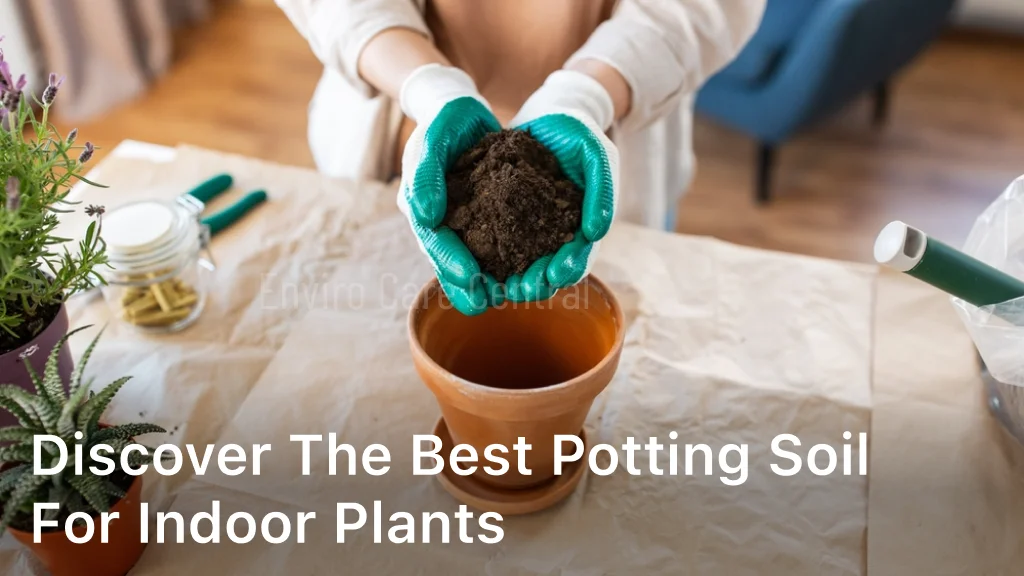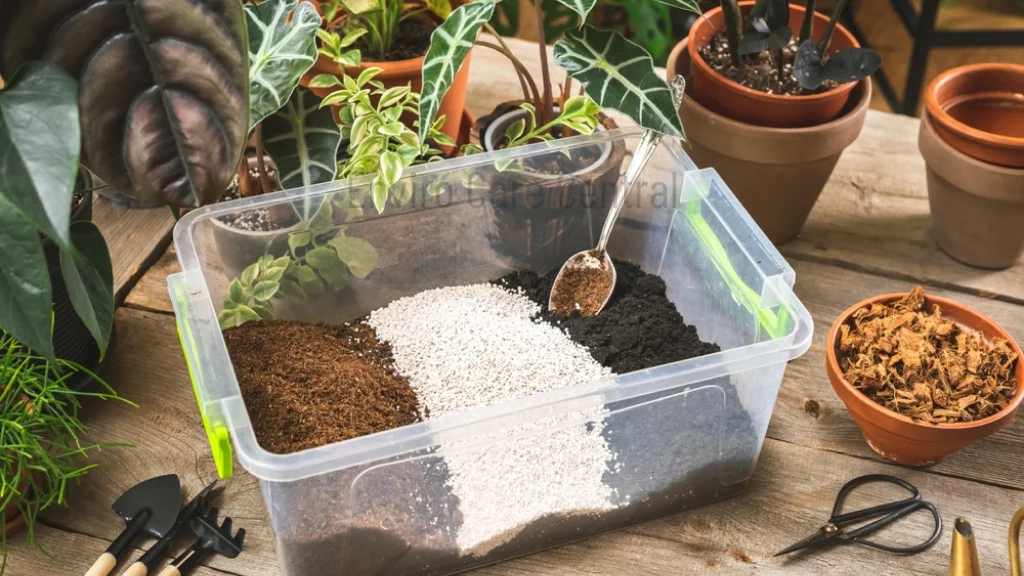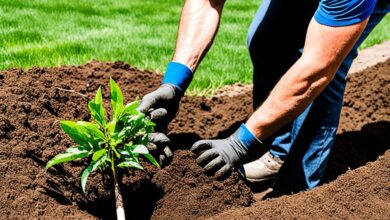Discover the Best Potting Soil for Indoor Plants

envirocarecentral.com. Discover the Best Potting Soil for Indoor Plants – Explore the best potting soil for indoor plants! Our guide helps you choose quality soil that nourishes your plants for lush, healthy growth.
Indoor plants have become a popular way to liven up living spaces and improve air quality, but they require proper care and attention to thrive. One critical aspect of caring for indoor plants is selecting the right potting soil.
The best potting soil for indoor plants provides essential nutrients, proper drainage, and support for root development, all of which are essential for healthy plant growth.
In this section, we’ll take a closer look at the qualities to look for in potting soil and provide recommendations for the top choices so you can be confident that your indoor plants are getting the best start possible.
Discover the Best Potting Soil for Indoor Plants
Key Takeaways:
- Choosing the best potting soil for indoor plants is crucial for their growth and health.
- The right potting soil provides essential nutrients, proper drainage, and support for root development.
- We’ll cover the top potting soil recommendations for indoor plants in this article.

Understanding the Importance of Quality Potting Soil
Indoor plants require specific care to thrive, and the right potting soil is essential to their overall health and growth.
Potting soil serves several crucial functions, including providing important nutrients, promoting proper drainage, and supporting root development. Potting soil also serves as the anchor for your indoor plants, keeping them stable and upright.
Indoor plants rely solely on the potting soil for their growth and development, making it a crucial component of their overall care.
Using poor quality or inappropriate soil can damage indoor plants and make them more susceptible to disease and pests. The wrong soil consistency can cause water to accumulate and lead to root rot, while soil lacking in vital nutrients can stunt growth and weaken the plant.
Therefore, it’s crucial to choose the appropriate potting soil for your indoor plants to ensure they receive the necessary care and support.
Factors to Consider When Choosing Potting Soil for Indoor Plants
When it comes to choosing the best potting soil for your indoor plants, there are several important factors to keep in mind. By considering these factors, you can ensure that your plants receive the proper nutrients and environment to grow and thrive.
1. Plant Species
The type of plant you have will play a significant role in determining the type of potting soil you need. Different plant species have different requirements in terms of moisture retention, drainage, and nutrient levels. For example, succulents and cacti require a well-draining soil mix with less moisture, while tropical plants prefer a soil mix that retains more moisture.
2. Water Retention
The ability of potting soil to retain water is a crucial factor in keeping your indoor plants healthy. Soil that retains too much water can lead to root rot, while soil that doesn’t retain enough water can cause your plants to dry out and wither. When selecting potting soil, be sure to check the water retention levels, and choose a soil mix that matches your plant’s moisture requirements.
3. Nutrient Content
Indoor plants rely on the nutrients in the potting soil to grow and thrive. When choosing potting soil, look for options that are rich in essential nutrients like nitrogen, phosphorus, and potassium. Organic potting soil mixes are often a great choice, as they contain natural materials that provide a steady supply of nutrients over time.
4. Soil pH
The pH level of the soil can impact the availability of nutrients for your indoor plants. Most plants prefer a soil pH that falls between 6.0 and 7.0. It’s a good idea to test the pH levels of your potting soil before using it for your plants. If the pH is too high or too low, you can add lime or sulfur to adjust the pH level accordingly.
5. Synthetic vs. Organic
When choosing potting soil for your indoor plants, you’ll also need to decide between synthetic and organic options. Synthetic potting soil mixes are often cheaper and more consistent in quality, while organic mixes are more sustainable and environmentally friendly. Consider your priorities and the needs of your plants when making this choice.
Top Recommendations for Potting Soil for Indoor Plants
Now that we’ve discussed the importance of quality potting soil and the factors to consider when selecting the best soil for your indoor plants, let’s dive into some top recommendations. Here are our top picks:
| Soil Name | Key Features | Plant Types |
|---|---|---|
| Organic Potting Mix | Contains beneficial organic matter Provides proper drainage Retains moisture effectively | Various indoor plants |
| Pro-Mix Premium Potting Mix | Lightweight and well-aerated Enriched with mycorrhizae for root development Low pH for acid-loving plants | Acid-loving plants such as african violets and ferns |
| Black Gold Natural & Organic Potting Soil | Blend of aged bark, earthworm castings, and compost Provides good drainage and moisture retention No added synthetic chemicals | All-purpose indoor plants |
| Espoma Organic African Violet Potting Mix | Specifically designed for african violets Rich in nutrients and minerals Excellent drainage | African violets |
| Miracle-Gro Indoor Potting Mix | Contains coconut coir, which retains moisture well Provides essential nutrients No added synthetic chemicals | All-purpose indoor plants |
These top recommendations are all excellent choices for indoor plants and provide a variety of benefits depending on your specific plant needs. Remember to consider factors such as plant type and nutrient content when making your selection.
Expert Tip: If you’re unsure which potting soil to choose, opt for an all-purpose mix like the Black Gold Natural & Organic Potting Soil. It’s versatile and suitable for most indoor plants.
How to Properly Use Potting Soil for Indoor Plants
Using potting soil for indoor plants is essential for their growth and well-being. However, improper usage can do more harm than good. Here are some tips on how to effectively use potting soil:
1. Repotting
If your indoor plant has outgrown its current pot, it’s time to repot it with fresh potting soil. Choose a pot that is one size bigger and fill it with new soil. Gently remove the plant from its old pot, being careful not to damage the roots. Place the plant in the new pot and add more soil around it, pressing it down gently to eliminate air pockets.
2. Transplanting
When transferring a plant from soil to a new pot, it’s important to select the right potting mix. Make sure the soil is moist before transplanting to reduce shock to the roots. Add a layer of potting soil to the bottom of the new pot and position the plant in the center, adding more soil around it until the pot is full.
3. Soil Maintenance
Regular soil maintenance is vital for the health of indoor plants. Check the soil moisture level often and water as needed. It’s important to avoid overwatering, as this can lead to root rot. Remove dead leaves and debris from the soil surface, and add fertilizer as recommended by the manufacturer.
4. Proper Watering Techniques
Water indoor plants properly by pouring water evenly on the soil surface until it drains from the bottom of the pot. Avoid watering the leaves or stem of the plant, as this can cause diseases. It’s also important to allow the soil to dry out between waterings to prevent overwatering.
5. Choosing the Right Soil
Choosing the right potting soil for your plant is crucial. Consider factors like water retention, nutrient content, and soil pH when selecting soil. Read labels carefully and choose soil specific to your plant’s needs.
By following these tips, you can ensure that your indoor plants thrive in their environment with the help of quality potting soil.
Common Mistakes to Avoid with Potting Soil and Indoor Plants
While selecting quality potting soil for your indoor plants is crucial, it’s equally important to avoid common mistakes that could harm your plants. Here are some mistakes to steer clear of when using potting soil:
- Overwatering: Overwatering your plants can cause soil to become waterlogged, which can lead to root rot and other issues. Always check the soil’s moisture level before watering and ensure proper drainage to avoid overwatering.
- Using the wrong type of soil: Different plant species have different soil requirements. Using the wrong type of soil can cause issues such as poor drainage, inadequate nutrient levels, and stunted growth. Do your research and select soil that is appropriate for the specific plant you are growing.
- Neglecting soil maintenance: Regular soil maintenance, such as removing dead leaves and debris, aerating soil, and adding fertilizer, is essential for maintaining healthy plant growth. Neglecting soil maintenance can lead to a buildup of harmful organisms and a decrease in soil quality.
- Not repotting as needed: As indoor plants grow, they require larger pots and fresh soil. Not repotting your plants as needed can stunt their growth and cause soil to become compacted, leading to poor drainage and inadequate nutrient absorption.
- Ignoring signs of stress: Indoor plants can give visible signs of stress, such as yellow leaves, wilting, and stunted growth. Ignoring these signs and not adjusting soil or care practices accordingly can cause long-term damage to your plants.
“Avoiding these common potting soil mistakes can help ensure your indoor plants thrive and remain healthy.”
Tips for Nurturing Indoor Plants with Quality Potting Soil
Nurturing indoor plants can be a rewarding experience, but it requires proper care and attention to thrive. Here are some tips for using quality potting soil to promote optimal plant growth:
- Watering: Proper watering is essential for indoor plants to thrive. Overwatering or underwatering can damage the plant’s roots or cause fungal growth. To avoid this, water your plants regularly, but only when the soil feels dry to the touch. Use a watering can or spray bottle to moisten the soil without oversaturating it.
- Fertilizing: Indoor plants require consistent nutrient supplementation to support their growth. You can use organic fertilizers or synthetic blends to provide these nutrients. Follow the instructions on the fertilizer package carefully, as too much fertilizer can lead to salt buildup in the soil.
- Pruning: Regular pruning can help indoor plants stay healthy and maintain their shape. Use a clean pair of shears or scissors to remove dead or yellowing leaves, as these can attract pests or diseases.
- Repotting: As indoor plants grow, they may outgrow their container and require repotting. Use a new container that’s slightly larger than the previous one to provide enough space for the plant’s roots to spread. When repotting, use fresh potting soil to prevent the buildup of harmful pathogens.
- Sunlight: Most indoor plants require adequate sunlight to thrive. Position your plants in a location that receives bright, indirect light for several hours each day. If your plants don’t receive enough sunlight, consider using grow lights to supplement their light intake.
By following these tips and using quality potting soil, you can create an optimal environment for your indoor plants to flourish. Remember to monitor your plants regularly and adjust their care routine as needed to support their growth.
Conclusion
Choosing the right potting soil is crucial for maintaining healthy indoor plants. By understanding the importance of quality soil, considering factors like plant species and water retention, and following proper usage and care techniques, you can create an optimal environment for your indoor plants to thrive.
Remember to avoid common mistakes like overwatering and using the wrong soil for specific plant types. With the right potting soil and proper care, your indoor plants can flourish and enhance the aesthetic and air quality of your home or office.
Thank you for reading our guide on the best potting soil for indoor plants. We hope you found it informative and helpful in your indoor gardening endeavors.
FAQ
What qualities should I look for in potting soil for indoor plants?
When choosing potting soil for indoor plants, it’s important to consider factors such as water retention, nutrient content, pH levels, and compatibility with the specific plant species.
Why is choosing the right potting soil important for indoor plants?
Quality potting soil plays a vital role in providing essential nutrients, promoting proper drainage, and supporting root development, all of which are crucial for the health and growth of indoor plants.
How do I properly use potting soil for indoor plants?
Proper utilization of potting soil involves techniques like repotting, transplanting, and regular soil maintenance. Following step-by-step instructions can help ensure the best results for your indoor plants.
What common mistakes should I avoid with potting soil and indoor plants?
Common mistakes to avoid include overwatering, using the wrong potting soil for specific plant types, and neglecting regular soil maintenance. These mistakes can negatively impact the health of indoor plants.
What are some tips for nurturing indoor plants with quality potting soil?
In addition to selecting the right potting soil, proper watering, fertilizing, and other care practices are essential. These tips can help promote the overall health and growth of your indoor plants.





